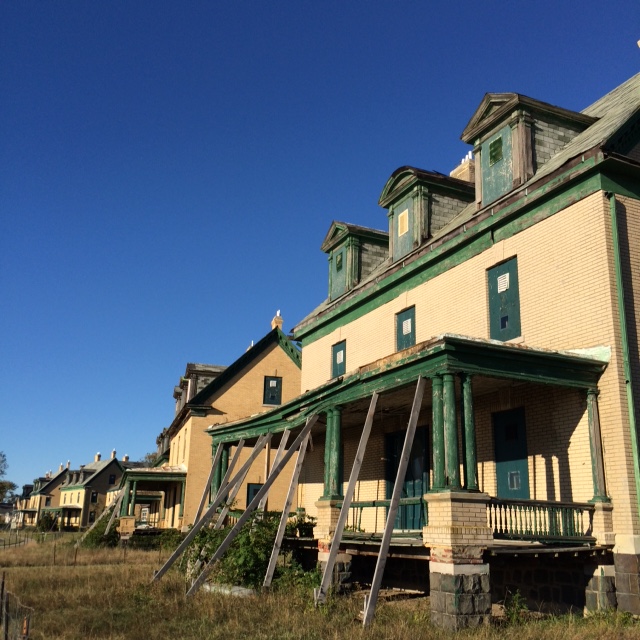A near ghost town awaits your visit in the Jersey Shore’s north end. Here in Sandy Hook, among New Jersey’s finest beaches and hiking trails, lies a cluster of historic structures that have very much weathered the sands of time.
These buildings are what remains of the defunct army post Fort Hancock, which provided coastal defense to New York Harbor from 1895-1974. The site’s historical significance actually predates this period, as the lighthouse is the oldest continuously operated lighthouse in the US, guiding ships into New York Harbor since 1764!

Neglected, decaying buildings are always haunting and these are no exception. These were more than just living quarters, but an all inclusive town for soldiers and their families. Construction began in 1898 and the original plan included 32 yellow brick buildings in the Colonial Revival style. The National Park Service’s walking tour brochure explains how the architecture suited military standards:
“Order and discipline are essential to maintaining not only a powerful military force but also a happy, well-adjusted military garrison. Army Quartermaster architects under- stood this and incorporated these ideas in the original design of Fort Hancock. Colonial Revival architecture was chosen for its simple, elegant lines and traditional form. Even the landscaping reflected a military sense of order. Trees were planted in rows like soldiers lined up for inspection.”
These are by no means (besides the lighthouse) the oldest structures. Just as I was about to leave, this decaying second empire beauty stopped me in my tracks. It’s the former Officers Club and was constructed in 1879:
By 1911, a commissary, post exchange, school, library, YMCA, chapel, bakery, laundry, and tailor shops were added. In subsequent years, the Fort grew to include a gymnasium with a bowling alley and a movie theater.
I would love the opportunity to see inside some of the (structurally sound!) buildings. In my research I stumbled upon this 2015 article about the National Park Service’s attempts to lease some of the buildings and breathe life back into the Fort. The article includes an awesome slideshow featuring contemporary and historic photos of the buildings. I long to see these crumbling interiors in person and imagine the many stories of the lives they inhabited.
Considering how much activity these structures once housed, the present quiet is extra strange and even unsettling. (Though my visit was in the fall and not during peak tourism season). I was fortunate to visit on such a beautiful, sunny day and I can’t resist mentioning how the lighting and stillness seem to give my photos an erie, Edward Hopper-like quality:


[The Lighthouse at Two Lights; Edward Hopper; 1929; Metropolitan Museum of Art]

While the Fort no longer echoes with military drills and other sounds of its past, it’s not bathed in silence. In the Fort’s second life, tourism contributes a pleasant murmur as history and nature admirers explore the grounds and surrounding beaches and trails.
Since the Fort’s closing in 1974, it has been used by the National Park Service and the National Guard. My spontaneous excursion was self-guided, but I’m so enamored that I long to return for a tour of the lighthouse, officer’s homes, YMCA building, and theater. As the NPS works to revitalize the Fort, hopefully they will successfully lease some of the buildings and return them to their former glory. The sun has hardly set on Sandy Hook.
Sources:
New York Harbor Parks
http://www.nyharborparks.org/visit/foha.html
Spoto, MaryAnn. “Another historic building for lease at Sandy Hook.” NJ.com September 18, 2015.
http://www.nj.com/monmouth/index.ssf/2015/09/another_historic_building_for_lease_at_sandy_hook.html
The National Park Service
https://www.nps.gov/gate/learn/historyculture/forthancockbuildings.htm
Click to access old_army_town.pdf
https://www.nps.gov/gate/learn/historyculture/hancock.htm
https://www.nps.gov/gate/planyourvisit/upload/Walking-Tour-Brochure.pdf




April 25, 2017 at 3:56 pm
Looks fascinating! Thanks for writing about it – its so interesting to hears about a place’s history! 🙂
April 25, 2017 at 10:58 pm
Thank you! I’m glad you liked reading it : ) It’s such a cool place and I long to go back.
April 26, 2017 at 6:35 pm
What a neat place; thanks for sharing! I’d love to explore it some day too! I’ve been reading a lot of Nathaniel Philbrick lately, and he mentions Sandy Hook a bit in the context of the American Revolution. Pretty cool that the lighthouse would have already been there at that time!
April 26, 2017 at 8:39 pm
I know, right?! Hopefully I’ll make it back soon to tour the lighthouse. I’ve only read one book by Philbrick so far – In the Heart of the Sea. I was really impressed with how well he synthesized so much material, so I’ll have to give his other work a shot.